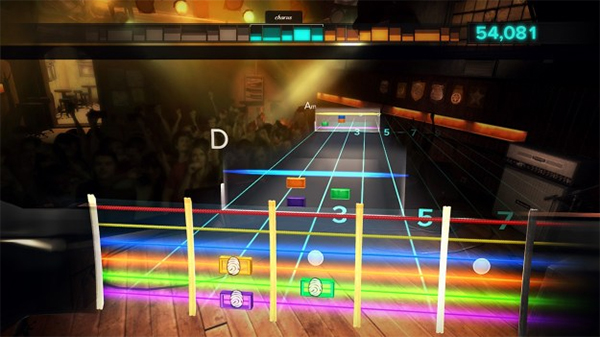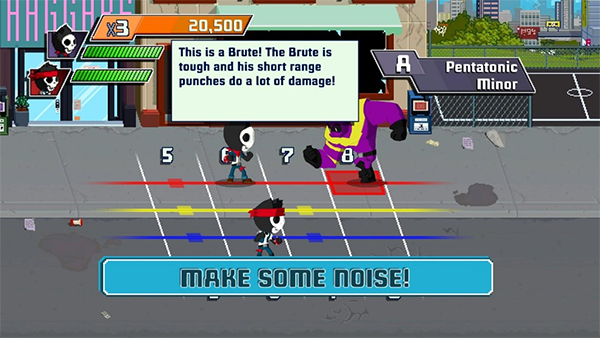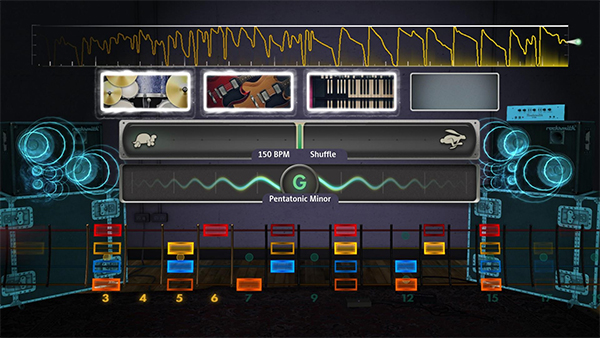Robots have not assumed control of our major cities and our children yet, but Rocksmith 2014 gets them one step closer. Unless you want to learn guitar from a video game and have fun doing it, don’t buy Rocksmith 2014 or else you may be contributing to our future subjugation. First the guitar teachers go, then the baristas, then our president. It’s an apocalyptic tale as old as time itself, and one that the developers at Ubisoft San Francisco are all too happy to usher in with their well-crafted, imaginative, and versatile guitar lesson software suite.
Although it sounds like just the next iteration in an inconsistent series of guitar tutorial games, Rocksmith 2014 marches to a different beat than its predecessor (Rocksmith from 2011). It’s clear that the team spent the three years between releases throwing out its pre-conceived notions about how a real guitar-based video game should function, and came back with something inspired by the spirit of the jam band. The focus here isn’t technical mastery (even though it flails in that direction at times), and it isn’t a nearly-universal song library (Rock Band’s go that on lock), but rather laying the foundation for enjoying the guitar’s many-fold musical functions. It’s an ambitious, well-constructed project that amateur guitarists and would-be bassists can learn a lot from, and that’s a huge achievement.
It’s worth noting that while the game ships with a quarter-inch-to-USB adapter cable, players will have to provide the really pricey hardware, the guitar itself. However, the game plays well enough with a variety of types of guitar (acoustic electric, electric, archtop, etc.), and doesn’t restrict players by manufacturer. Bassists can also plug in and get bass tutorials and play bass tracks alongside the guitar-focused content. That’s about as wide as Ubisoft can throw that gate, I imagine, and it will work for almost anyone with electronics on their guitar. For the purposes of this review, we’ll focus on gameplay using an electric guitar (an American series Fender Telecaster, precisely), which seems to be what the developers primarily had in mind when designing the game.
 Rocksmith 2014 is most familiar when it mimics the now decade-old formula for guitar games popularized by Guitar Hero, with the distinguishing difference being its use an actual guitar, complete with six strings, 20+ frets, at least one pickup, and a pick. In order to translate that formula onto a more complex instrument, the interface scrolls through notes color-coded by string and marked positionally and numerically for frets. For guitarists used to tablature notation, this is like an upside down version of that, and coming at you fast. The learning curve for the interface itself is several hours depending on the guitarist’s ability to look at the screen instead of at his/her hands. It’s not a perfect system, but it might be the best a game like this can do to meet the expectations for gamers and veteran guitarists alike.
Rocksmith 2014 is most familiar when it mimics the now decade-old formula for guitar games popularized by Guitar Hero, with the distinguishing difference being its use an actual guitar, complete with six strings, 20+ frets, at least one pickup, and a pick. In order to translate that formula onto a more complex instrument, the interface scrolls through notes color-coded by string and marked positionally and numerically for frets. For guitarists used to tablature notation, this is like an upside down version of that, and coming at you fast. The learning curve for the interface itself is several hours depending on the guitarist’s ability to look at the screen instead of at his/her hands. It’s not a perfect system, but it might be the best a game like this can do to meet the expectations for gamers and veteran guitarists alike.
The songs on the original roster for the game don’t fill the same kind of nostalgic space that the Guitar Heros and Rock Bands of the world do. The focus here is clear: these are songs that require multiple levels of guitar proficiency to play. So, for example, the amateur guitarist can get started on the bass line from “More Than A Feeling,” while the intermediate guitarist can do the song’s acoustic chord part, while the veteran guitarist can wail away on its classic Boston guitar solos. More contemporary tunes fill out the set list alongside some golden oldies, particularly those with burning tap-filled licks.
The skill sets for songs follow three tracks that players pick when they start the game but can jump between as desired: Lead Guitar, Rhythm Guitar, and Bass. Lead starts simply but ramps up the complexity quickly, while Rhythm Guitar has a steep initial learning curve of chord formations, followed by something of a plateau. Bass is probably the best place to start, even for the guitarist, because it introduces players to notes, primarily on the lower strings, and occasional scale work.
 But listen, of COURSE everyone who picks up this game wants to play a screaming solo, so most folks will pick lead. The big caveat here is that Rocksmith 2014 is great for practicing some simpler lead lines and getting guitarists’ fingers used to finding their places in between the frets and on the right strings. But the Master difficulty on the more advanced songs — the screaming solos as they are actually played – are incredibly difficult to learn using the upside-down conveyor belt tablature that works well for everything else. The notes simply come in too fast. Riff repeat allows players to slow these segments down and repeat them, but a much more efficient method would be to navigate to an online tab site and get the whole thing on the screen at once. This doesn’t hold the game back, necessarily, but just adds a wrinkle for advanced axemen.
But listen, of COURSE everyone who picks up this game wants to play a screaming solo, so most folks will pick lead. The big caveat here is that Rocksmith 2014 is great for practicing some simpler lead lines and getting guitarists’ fingers used to finding their places in between the frets and on the right strings. But the Master difficulty on the more advanced songs — the screaming solos as they are actually played – are incredibly difficult to learn using the upside-down conveyor belt tablature that works well for everything else. The notes simply come in too fast. Riff repeat allows players to slow these segments down and repeat them, but a much more efficient method would be to navigate to an online tab site and get the whole thing on the screen at once. This doesn’t hold the game back, necessarily, but just adds a wrinkle for advanced axemen.
Like any modern RPG (which it is in many ways), Rocksmith 2014 goads players along with short, simple goals and plenty of unlockable gear and sounds. While players jamming to the pre-recorded tracks of yesterday and today will find themselves screaming with each recording’s signature mix, they’ll also open up access to new virtual gear for just about every activity in the game. The gear ranges from guitars to pedals to cabinets to conditioners from all the big name manufacturers. Gear-heads will experience a mild euphoric shock, like being at Guitar Center when nobody else is around. Amateur effects users will learn a thing or two about sound mechanics and manipulation.
Rocksmith 2014’s playful voice sounds the clearest in the Guitarcade, a collection of 8-bit style minigames that challenge players to use basic guitar skills in repetition to move, fight, drive, dodge, and win. For example, Skip String Saloon plots the six strings of the guitar onto six enemy lanes into a saloon that players must defend by plucking the string that corresponds with the lane an enemy occupies. Castle Chordead charges players with defeating a horde of undead foes by playing power chords that flash above their heads. Rocksmith 2014 finds its best asset for new and beginning guitarists in the Guitarcade, where the repetition necessary for eventual dexterity and mastery is made that much more bearable and fun. Scales practice doesn’t have to be so awful anymore!
 And if the Guitarcade was developed for the newbs, then Session Mode was developed for guitarists that already pwn. It’s also the most original element in the game, and one of the most terrifying. We may be entering an era where the garage band is no longer the standard opportunity for a young musician to awkwardly hone his or her craft, because Ubisoft has at least started to figure out how to virtualize an improvisatory jam band. Players just set the key they want to play in, the complexity of the chord structure, the accompanying instruments, and the starting tempo, then they are off to the races. As players speed up or slow down, or move dynamically, the band goes with them.
And if the Guitarcade was developed for the newbs, then Session Mode was developed for guitarists that already pwn. It’s also the most original element in the game, and one of the most terrifying. We may be entering an era where the garage band is no longer the standard opportunity for a young musician to awkwardly hone his or her craft, because Ubisoft has at least started to figure out how to virtualize an improvisatory jam band. Players just set the key they want to play in, the complexity of the chord structure, the accompanying instruments, and the starting tempo, then they are off to the races. As players speed up or slow down, or move dynamically, the band goes with them.
This is a particular joy for lead guitarists who have languished in silent, unaccompanied bedroom studios for years. Now, within a couple of clicks, a player can throw a bass, a drum kit, a synth player, and that weird percussion guy underneath his endless jam session. And with the diversity of instruments and potential chord progressions, this technology could theoretically be used in songwriting, at least on a simplistic level.
There are a couple of quirks to work out with this mode, particularly with some of the chord structures that aren’t the 12-bar blues. Without any kind of predictive or forecasting interface, the band can change to an unexpected chord suddenly and without warning, leaving the lead player high and dry. There’s a chart at the bottom of the screen that shows what lead notes would be acceptable during any given chord, but this often rings with a sour note or two before correcting. Something like a virtual conductor might resolve this minor issue. Most guitarists, though, will probably just jam on that Pentatonic scale for days. And days.
And this is what makes Rocksmith 2014 such a success; it’s well-executed in its note recognition, cleverly structured in its tutorials and optional modes, and satisfyingly deep for the love of the music. In time, no doubt, the note recognition technology driving this engine will become even more accurate, and the inventive ways of reimagining the guitar’s role in playing games will continue to evolve. With games like Rocksmith 2014, it’s no wonder that the Guitar Hero era has ended. The age of the virtual band has begun.


















